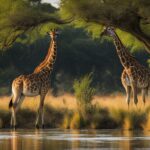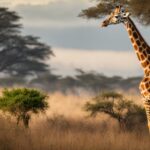Curious about the lifespan of giraffes? Wondering how long these magnificent creatures live in their natural habitat? In this article, we will explore the average lifespan of giraffes, their unique traits, and the challenges they face to survive in the wild.
Factors Influencing Giraffe Lifespan
Giraffes, like any other species, are influenced by various factors that contribute to their lifespan in the wild. These factors can impact their survival rate and mortality rate, shaping the overall population dynamics. Predation, disease, starvation, territorial fights, and habitat loss are some of the key factors that can affect the lifespan of giraffes.
Predation: Predation plays a significant role in the lifespan of giraffes. Natural predators such as lions, hyenas, leopards, wild dogs, and crocodiles pose a threat to both young and adult giraffes. Sub-adults and calves are particularly vulnerable to predation, resulting in a higher mortality rate for these age groups.
Disease and Starvation: Giraffes can also face health challenges that can impact their lifespan. Disease outbreaks and nutritional deficiencies in their habitat can lead to weakened immune systems and increased vulnerability to predation. Availability and quality of food sources can also affect their overall health and survival.
Quote: “The survival of giraffes is directly linked to their ability to navigate and adapt to the challenges present in their environment.” – Wildlife Conservation Society
Habitat Loss: The loss of suitable habitat due to land conversion for agriculture and urbanization poses a significant threat to giraffes. As their natural habitat shrinks, giraffes face increased competition for resources, limited space for movement, and reduced opportunities for reproduction. This can further impact their survival and overall population size.
Giraffes have developed various adaptations to cope with these challenges, such as their towering height, strong immune systems, and keen senses. However, the conservation and preservation of their natural habitat are vital to ensure the long-term survival of these magnificent creatures.
Factors Influencing Giraffe Lifespan Table
| Factors Influencing Giraffe Lifespan | Impact |
|---|---|
| Predation | Threat to both young and adult giraffes; higher mortality rates for sub-adults and calves |
| Disease and Starvation | Increased vulnerability to predation; weakened immune systems; nutritional deficiencies |
| Habitat Loss | Competition for resources; limited space for movement; reduced opportunities for reproduction |
It is crucial to address these factors and implement effective conservation measures to protect and sustain giraffe populations. By raising awareness, supporting habitat preservation, and mitigating human-induced threats, we can contribute to the longevity and well-being of these magnificent creatures for generations to come.
Giraffe Life Cycle and Development
Giraffes have a unique life cycle and development. From gestation to maturity, their journey is filled with remarkable growth and milestones. Let’s take a closer look at the stages of a giraffe’s life:
1. Gestation and Birth
The gestation period for giraffes is typically 13-15 months, making it one of the longest among land animals. When a female giraffe is ready to give birth, she retreats to a calving area she will use throughout her life. The birth itself is an incredible sight, as the newborn calf is born while the mother is standing. Within an hour of birth, the calf can already stand and nurse. They are approximately 6 feet tall and weigh between 100 and 150 pounds, entering the world ready to explore their surroundings.
2. Rapid Growth
Giraffe calves grow rapidly in their first year of life. They gain approximately 4 inches in height each month, reaching a height of around 12 feet by their first birthday. This rapid growth is facilitated by their nutritious milk and a diet that consists primarily of leaves from acacia and other trees. As they continue to grow, their legs become longer and their necks elongate, allowing them to reach higher food sources.
3. Independence and Maturity
Giraffe calves are weaned at one year of age and start to become more independent. By 15 months, they can fully care for themselves and are considered mature. Female giraffes reach sexual maturity at around 3-4 years old, while males typically mature around 6-7 years old. Once they reach maturity, giraffes are ready to start their own families and contribute to the continuation of their species.

| Life Stage | Description |
|---|---|
| Gestation and Birth | Giraffes have one of the longest gestation periods, typically lasting 13-15 months. Calves are born while the mother is standing and can stand and nurse within an hour of birth. |
| Rapid Growth | Giraffe calves experience rapid growth, gaining approximately 4 inches in height each month during their first year. By their first birthday, they can reach a height of around 12 feet. |
| Independence and Maturity | Giraffe calves are weaned at one year and become fully independent by 15 months. Female giraffes reach sexual maturity at around 3-4 years, while males reach maturity around 6-7 years. |
Throughout their life cycle, giraffes go through incredible changes and adaptations that allow them to thrive in their unique ecosystems. From the moment they are born, to their rapid growth and eventual independence, giraffes are a testament to the wonders of nature.
Giraffe survival traits and adaptations
Giraffes possess remarkable traits and adaptations that contribute to their longevity and ability to thrive in their natural habitat. These unique characteristics have allowed them to survive and evolve over millions of years. Here are some of the key survival traits and adaptations that make giraffes truly exceptional creatures:
1. Towering Height and Specialized Anatomy
The most distinctive feature of a giraffe is its incredible height, which enables it to reach food sources that are inaccessible to other animals. With their long necks and legs, giraffes can browse on leaves and foliage high up in the trees, where other herbivores cannot reach. Their skeletal structure and musculature are specially adapted to support their tall stature, with durable bones and powerful muscles. Additionally, giraffes have a large heart and blood vessels that help pump blood up to their heads, allowing them to overcome the challenges posed by gravity.
2. Prehensile Tongue and Lips
Giraffes have long, prehensile tongues and fleshy lips that enable them to strip leaves from branches without injuring themselves. Their tongues are also tough and flexible, allowing them to grasp and manipulate vegetation with precision. This unique adaptation helps giraffes efficiently obtain their primary food source and maintain their nutritional needs in their vast habitat.
3. Ruminant Digestive System
Giraffes have a specialized digestive system that allows them to efficiently process their fibrous diet. They are ruminants, meaning they have a four-chambered stomach that aids in the breakdown and fermentation of plant matter. This adaptation enables giraffes to extract maximum nutrients from their food, even though their diet primarily consists of tough and low-nutrient vegetation.
4. Excellent Eyesight and Sense of Hearing
Giraffes have large, expressive eyes situated on the sides of their heads, providing them with a wide field of vision. This keen eyesight helps them detect predators from a distance, allowing them to remain vigilant and prepared for any potential threats. Additionally, they have a highly developed sense of hearing, which further enhances their ability to sense danger and communicate with other members of their herd.
These remarkable survival traits and adaptations have allowed giraffes to thrive in their challenging habitat. As we continue to learn more about these fascinating creatures, it is crucial that we work towards their conservation and ensuring the long-term survival of giraffe populations.
Giraffe Conservation and Threats to Their Survival
Giraffes are currently facing numerous challenges that threaten their survival. Conservation efforts are crucial to protect giraffe populations and their natural habitats.
One of the primary threats to giraffes is habitat loss. As land is converted for agriculture and urban development, giraffes lose crucial feeding and breeding grounds. This loss of habitat not only limits their food sources but also disrupts their social structures and mating patterns. It is essential to raise awareness about the impact of habitat loss and work towards preserving and restoring the habitats that giraffes rely on for survival.
Giraffe hunting is another concern that can have a detrimental impact on giraffe populations. While hunting for giraffe meat and other body parts is not yet catastrophic, it is important to implement strict regulations and enforcement to prevent further decline in their numbers. By promoting responsible and sustainable practices, we can ensure that giraffes are protected from overhunting and illegal poaching.
“Conservation is the key to securing the long-term survival of giraffes. By protecting their habitats and raising awareness about the importance of preserving giraffe populations, we can contribute to their continued existence.”
The efforts to conserve giraffes also extend to education and community involvement. It is crucial to engage local communities living near giraffe habitats and involve them in conservation initiatives. By providing alternative livelihood opportunities and promoting eco-tourism, we can create incentives for communities to value and protect giraffes and their habitats.
Giraffe Conservation Strategies
To address the threats faced by giraffes, several conservation strategies are being implemented:
- Establishing protected areas and national parks to safeguard giraffe habitats and populations.
- Participating in breeding programs and maintaining viable captive populations for conservation and research purposes.
- Collaborating with local communities and stakeholders to support sustainable land-use practices that benefit both people and giraffes.
- Increasing public awareness through education programs and promoting responsible wildlife tourism.
By implementing these conservation strategies and prioritizing the protection of giraffes and their habitats, we can ensure that future generations will continue to witness the grace and beauty of these extraordinary creatures.
Giraffe Population Numbers
| Region | Estimated Giraffe Population |
|---|---|
| Southern Africa | Approximately 52,000 |
| Eastern Africa | Approximately 36,000 |
| Western and Central Africa | Approximately 6,500 |
| Total Worldwide | Approximately 94,500 |
The table above provides estimated giraffe population numbers in different regions. While these numbers serve as a general indication, it is important to note that population sizes can fluctuate due to various factors such as poaching, habitat loss, and conservation efforts. Continued monitoring and conservation initiatives are essential to ensure accurate population assessments and effective conservation actions.
Conclusion
In conclusion, the average lifespan of a giraffe in the wild is estimated to be around 25 years, although some individuals have been known to live longer in captivity. Giraffes face various challenges to their survival, including predation, disease, and habitat loss.
However, giraffes have unique traits and adaptations that contribute to their ability to thrive in their natural environment. Their towering height, long prehensile tongues, and large heart and blood vessels all play a role in their longevity and survival. Additionally, their keen senses, spotted coat pattern, and remarkable speed and kicking power help fend off predators.
Conservation efforts are crucial to protect giraffe populations and their habitats. With habitat loss and hunting posing significant threats, it is essential to raise awareness about the importance of preserving giraffes. By implementing conservation measures and supporting organizations dedicated to giraffe conservation, we can help ensure the long-term survival of these magnificent creatures.
Do natural predators of giraffes impact their average lifespan in the wild?
Giraffes roam freely in the wild, facing the constant threat of natural predators of giraffes in the wild. These predators play a crucial role in shaping the average lifespan of giraffes. Their presence ensures that only the fittest and most adapted giraffes survive, thus maintaining a healthy population and preserving the species’ resilience in their natural habitat.
FAQ
What is the average lifespan of a giraffe in the wild?
The average lifespan of a giraffe in the wild is estimated to be around 25 years, with some individuals living longer in captivity.
What factors influence giraffe lifespan?
Giraffe lifespan can be influenced by factors such as predation, disease, starvation, and territorial fights with other giraffes.
How does the life cycle of a giraffe develop?
Giraffes have a gestation period of 13-15 months. Calves are born while the mother is standing, and they can already stand and nurse within an hour of birth. They grow rapidly during their first year.
What survival traits and adaptations do giraffes have?
Giraffes have a towering height that allows them to reach food sources, long prehensile tongues and fleshy lips for feeding, a large heart and blood vessels to support their tall stature, excellent eyesight and hearing, and a spotted coat pattern for camouflage.
What are the threats to giraffe survival?
Giraffe populations are threatened by habitat loss due to land conversion, hunting for hide, hair, and meat, and the lack of protection outside of national parks and game reserves.
How can giraffe conservation efforts help?
Conservation efforts are focused on protecting giraffe habitats and raising awareness about the importance of preserving giraffe populations for their long-term survival.







